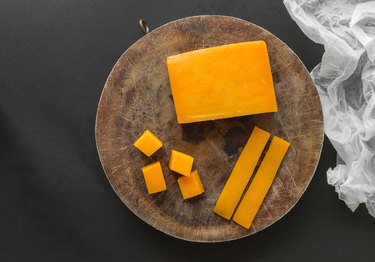
Making your own cheddar sauce for pasta may seem like a difficult thing to do, especially if you're using a block of cheese instead of the pre-shredded stuff, but it's actually really easy. You only need a few ingredients that you likely have on hand already.
The key is to take your time and make sure all of the cheese gets incorporated into the sauce slowly and carefully. Then, once you're done, you can use your homemade cheese sauce for pasta, vegetables or in place of any other cheese dip recipes.
Video of the Day
Video of the Day
Gather and Prep Your Ingredients
The first thing you need to do make cheese sauce out of a block of cheese is shred your cheese. If you're short on time, you can use pre-shredded cheese instead of a block, but there are several benefits of shredding the cheese yourself.
Pre-shredded cheese often contains preservatives, like potato starch or cellulose, that help prevent the cheese from clumping, according to Ochsner Health. But these preservatives also interfere with the way the cheese melts.
You'll often find pre-shredded cheese that won't melt as easily or when it does melt, it leaves clumps and lumps in your cheese sauce. Pre-shedded cheese also has a different texture. Because a block of cheese doesn't have the same preservatives, you'll end up with a creamier sauce that tastes fresher, too.
As an added bonus, you can generally get more out of a block of cheese compared to a bag of shredded cheese. An 8-ounce bag of pre-shredded cheese has about 2 cups of cheese in it, but an 8-ounce block will get you about 2 1/2 cups.
To make the cheese sauce, you'll need two cups of shredded sharp cheddar cheese, plus:
- 1/4 cup unsalted butter
- 2 tablespoons finely minced onion
- 1/4 cup flour
- 2 cups milk
- 2 teaspoons dry mustard
- 1/4 teaspoon salt
Make Your Sauce
Once you have all your ingredients gathered, you need to make what's called a roux. A roux is a fancy term for a combination of flour and fat (usually butter) that's cooked and used to thicken a sauce. The Celiac Disease Foundation points out that the roux will add gluten, so keep that in mind if you're gluten-sensitive or serving the cheese sauce to someone who is.
To make your roux, melt the butter in a saucepan over medium heat. Once the butter is melted and hot, add the onion and cook for about five minutes or until the onions are translucent and soft. Use a whisk to stir in the flour and continue whisking until smooth.
Keep cooking, while stirring, for another two to three minutes. Stir in milk and reduce heat to medium-low. At this point, it's really important to watch your sauce carefully because you don't want your milk to burn. If it does, it will affect the taste of your finished cheese sauce.
Stir the milk continuously in the hot saucepan until it starts to thicken, about five minutes. If you think the milk is getting too hot, you can reduce the temperature a little bit. You should see little bubbles forming on the sides of the saucepan, but don't allow it to boil.
After the milk has thickened, stir in the dry mustard and salt, then add your shredded cheese slowly. The best way to melt cheese is add a little to the pan at a time, stir it until it melts and then add some more. If you put all the cheese in at once, it won't melt evenly and you could be left with a clumpy sauce.
After all of your cheese is incorporated into the sauce, allow it to cook on low for another five minutes and then remove it from the heat. You can use the cheddar cheese sauce for pasta or as a topping for cooked broccoli or cauliflower, which, as Harvard Health notes, is a great substitute for starchy foods like pasta, especially if you're on a low-carb diet.
Though a healthy lifestyle is all about balance, a calorie-dense and fatty cheese sauce is best eaten in moderation. Use it to jazz up your veggies every once and a while, but keep your portions in check — try a spoonful or two rather than a ladle full — and don't make it a part of your daily diet.
- Taste of Home: "3 Surprising Reasons Why You Should Always Grate Your Own Cheese"
- Real California Milk: "Basic Cheese Sauce"
- Ochsner Health: "Store Bought Shredded Cheese: Debunking the Myths and Best Picks"
- Celiac Disease Foundation: "Sources of Gluten"
- Harvard Health Publishing: "Vegetable of the Month: Cauliflower"